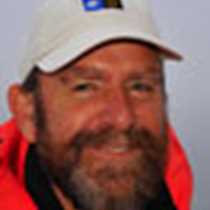Petersburg, Thomas Bay and Cascade Creek
At first light we threaded the Wrangell Narrows to enter the fishing port of Petersburg. The harbour bristles with fishing boats, which harvest salmon, crab and halibut from the rich local waters. It was an early start for us: a bus was waiting to take us across the point to Sandy Bay where we walked out at low tide to witness an extraordinary sight: a 2000-year old Tlingit fish trap. Centuries ago, local Indians constructed a heart-shaped pattern of hemlock stakes reinforced with boulders, to lead migrating salmon into a central circle of hurdles. As the tide fell, they were left flapping in the shallows, a source of fresh summer fish, to be dried and smoked as a winter food. Just above the tide mark on a shale outcrop we were shown mysterious petroglyphs, bug-eyed, open-mouth faces carved out of the rock, whose significance is now long forgotten.
After a late and well-earned breakfast, we explored the exotic delights of the town, where the locals are instantly recognizable by their “Petersburg Sneakers”, brown Wellingtons which they wear for fishing, shopping, strolling, weddings and funerals. Others took a Zodiac across the Narrows to go bog-trotting. A short hike (pausing only to snack on bilberries, salmonberries and thimbleberries) led us onto a muskeg boardwalk. This is blanket bog, a raised dome of Sphagnum moss with stunted pines, peaty pools and the weirdest flora imaginable: carnivorous plants like Round-leaved Sundew, which eke out a lean living by trapping insects on their sticky-fingered tentacles. To cap it all, the sun came out and a Steller’s Jay, the state bird of Alaska, landed above us in all its purple-blue finery.
Outward bound for Thomas Bay, we were joined by Dr. Fred Sharpe who gave us some insights into the behavior of the Alaska humpbacks, which he has been studying for the last 20 years. Much to his delight, his talk was curtailed by a cry of “Orcas” and we sprang for the bow in time to see two killer whales hunting salmon where tidal streams clashed. While we watched them surface and feed in tandem, he treated us to an impromptu orca seminar, answering dozens of eager questions. A full day was rounded off by landing at Cascade Creek, and hiking for two strenuous miles over moss-covered boulders, peaty quagmire and toppled spruce giants. All to see a river in spate, as it flung itself through a narrow canyon, hurtled over a ledge and exploded in a cloud of windy spray at the foot of the forest. Exilharated we returned drenched in spray, spattered with mud, steaming with exertion, but thrilled by a raw Alaskan wilderness experience.
At first light we threaded the Wrangell Narrows to enter the fishing port of Petersburg. The harbour bristles with fishing boats, which harvest salmon, crab and halibut from the rich local waters. It was an early start for us: a bus was waiting to take us across the point to Sandy Bay where we walked out at low tide to witness an extraordinary sight: a 2000-year old Tlingit fish trap. Centuries ago, local Indians constructed a heart-shaped pattern of hemlock stakes reinforced with boulders, to lead migrating salmon into a central circle of hurdles. As the tide fell, they were left flapping in the shallows, a source of fresh summer fish, to be dried and smoked as a winter food. Just above the tide mark on a shale outcrop we were shown mysterious petroglyphs, bug-eyed, open-mouth faces carved out of the rock, whose significance is now long forgotten.
After a late and well-earned breakfast, we explored the exotic delights of the town, where the locals are instantly recognizable by their “Petersburg Sneakers”, brown Wellingtons which they wear for fishing, shopping, strolling, weddings and funerals. Others took a Zodiac across the Narrows to go bog-trotting. A short hike (pausing only to snack on bilberries, salmonberries and thimbleberries) led us onto a muskeg boardwalk. This is blanket bog, a raised dome of Sphagnum moss with stunted pines, peaty pools and the weirdest flora imaginable: carnivorous plants like Round-leaved Sundew, which eke out a lean living by trapping insects on their sticky-fingered tentacles. To cap it all, the sun came out and a Steller’s Jay, the state bird of Alaska, landed above us in all its purple-blue finery.
Outward bound for Thomas Bay, we were joined by Dr. Fred Sharpe who gave us some insights into the behavior of the Alaska humpbacks, which he has been studying for the last 20 years. Much to his delight, his talk was curtailed by a cry of “Orcas” and we sprang for the bow in time to see two killer whales hunting salmon where tidal streams clashed. While we watched them surface and feed in tandem, he treated us to an impromptu orca seminar, answering dozens of eager questions. A full day was rounded off by landing at Cascade Creek, and hiking for two strenuous miles over moss-covered boulders, peaty quagmire and toppled spruce giants. All to see a river in spate, as it flung itself through a narrow canyon, hurtled over a ledge and exploded in a cloud of windy spray at the foot of the forest. Exilharated we returned drenched in spray, spattered with mud, steaming with exertion, but thrilled by a raw Alaskan wilderness experience.




